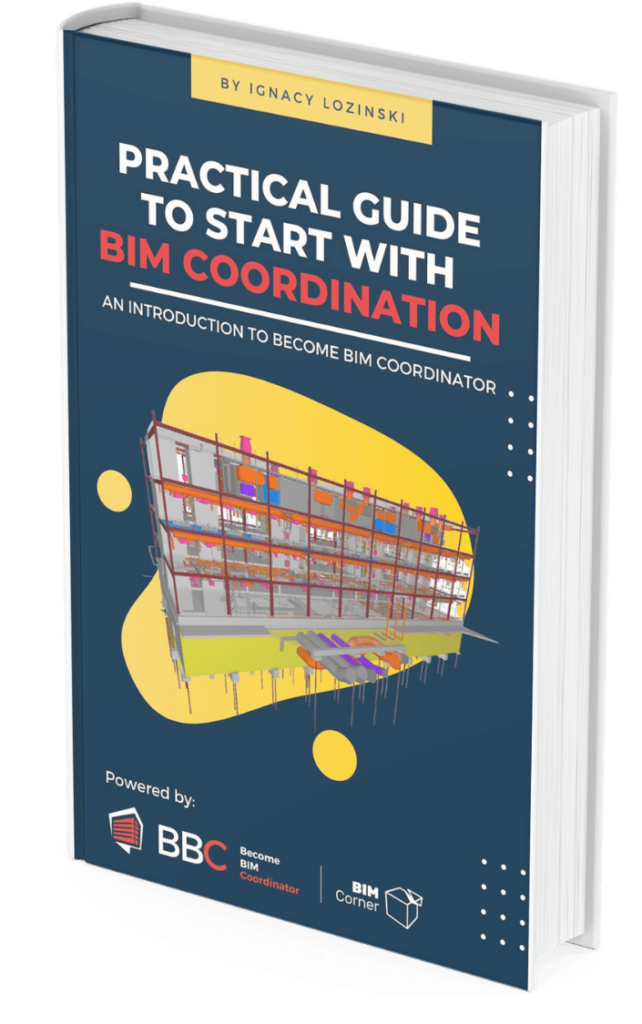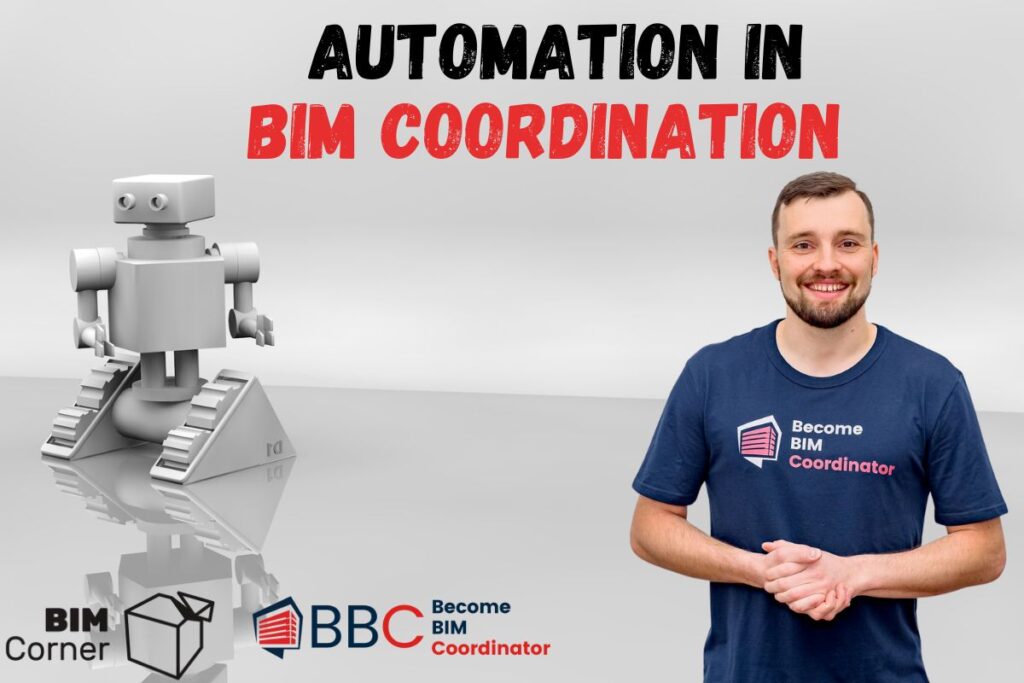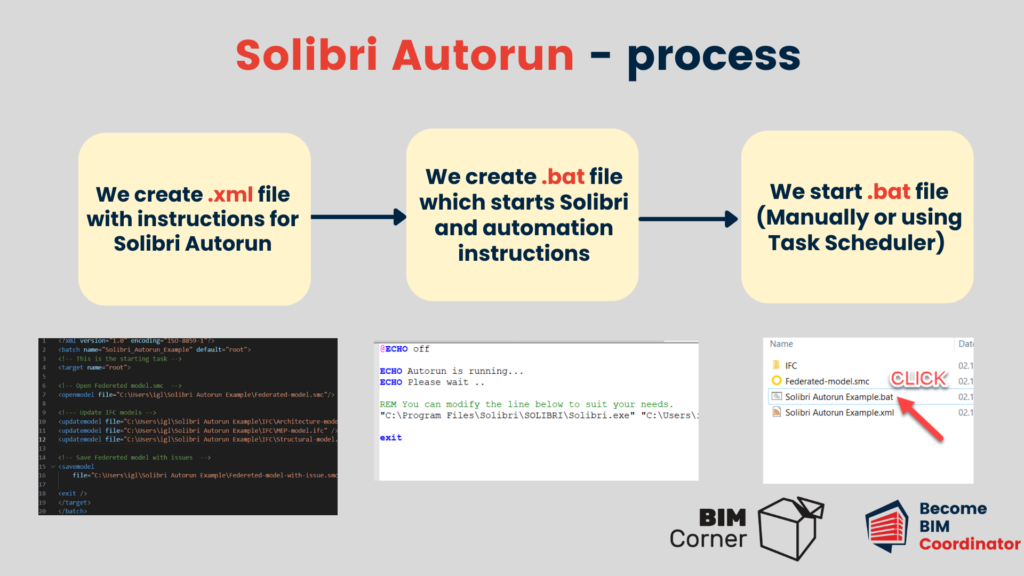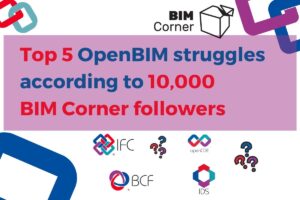Technology currently offers us many opportunities. New tools and applications are helping architects and engineers do their jobs more effectively. These tools are getting better, but they are also getting more complicated.
Today, the average engineer has a lot more to do than he did a few decades ago. Automation in our industry is not a trend, but a must.
Thanks to automation, we can save a large number of hours that we can use for creative work that cannot be replaced by a machine.
In today’s post, I would like to delve into the topic of automation and show you a simple example of how BIM coordinators can make their jobs easier by using “robots” to do their work.

DO YOU WANT TO BECOME A BIM COORDINATOR ? CHECK AN ONLINE PROGRAM TO BOOST YOUR CARRER IN BIM
What is Solibri Autorun and how can it help?
Solibri Autorun is an extension of Solibri Office for automating routine tasks that can be executed at a time convenient for you (e.g. overnight).
The extension predefines tasks such as performing checks, exporting the problems found as BCF files, and creating presentations in an XML file specified as a command line argument or scheduled task for running Solibri.
I encourage you to check website – Solibri Autorun – where you can find instructions on how to use the programme.
Solibri Autorun can do many different things for us. It allows us to create different scenarios of automation.
It is very good to choose an example and see how it can be implemented in your work. What do you think if I tell you that after this article you will be able to do it without your action:
1. Open a multidisciplinary model in Solibri (read more about multidisciplinary models here)
2. Update the IFC models that are in the multidisciplinary model,
3. Check the model,
4. Create a presentation that includes issues found during the coordination process
5. Save the presentation as a report in BCF format (learn more about BCF format here)
6. Save all changes made in the multidisciplinary model and exit the program
By automating the above steps, we can save anywhere from a few dozen minutes to several hours of our precious time, depending on the size of the multidisciplinary model.
Sounds great, doesn’t it?
Let us take a look at what we have to do to make such an automation.
What should we have before we start automation?
To start with the above automation you should have:
- Solibri Office program 9.10 version or newer
- Good text editor. I use the free Visual Studio Code, but I know many others who use Notepad++
- 30-60 min free time 😉
Let's automate
- In the first step, we create an XML file that contains the instructions that Solibri Autorun has to do for us
- Next, we create a file.bat that hooks us into Solibri and executes the instructions in the XML file from the previous step
- The last step is to enable automation by clicking on the .bat file or using the Task Scheduler tool (more on this later)
Let’s start.
Step 1: We create a file .xml
In this part, we will create a .xml file. XML is a universal markup language that can be used to represent a variety of data in a structured way.
Let us return to our scenario. We have some steps to do
1. Open multidisciplinary model in Solibri
In this case, the multidisciplinary model is a file named Federated-model.smc, which is located in the path:
C:\Users\igl\Solibri Autorun Example
(Remember that this path will look different on your computer)
<?xml version="1.0" encoding="ISO-8859-1"?>
<batch name="Solibri_Autorun_Example" default="root">
<!-- This is the starting task -->
<target name="root">
<!-- Open Federeted model.smc -->
<openmodel file="C:\Users\igl\Solibri Autorun Example\Federated-model.smc"/>
- the code lines from 1 to 4 are the standard startup code of Solibri Autorun and start your automation files this way. In line 2 you just change the name to batch name=”Solibri_Autorun_Example” – define your XML file name, for me it is “Solibri Autorun Example”.
- The lines starting with <!– and ending with –> are the comments in XML language. You can write anything in between. They are used to explain what the commands in the code will do.
- In the 7th line the command <openmodel file=> opens the multidisciplinary model. After the = character, enter the path where the Federeted-model.smc on your PC is located.
2. Update IFC models that are in a multidisciplinary model.
In the next lines, copy the code below:
<!-- Update IFC models -->
<updatemodel file="C:\Users\igl\Solibri Autorun Example\IFC\Architecture-model.ifc" />
<updatemodel file="C:\Users\igl\Solibri Autorun Example\IFC\MEP-model.ifc" />
<updatemodel file="C:\Users\igl\Solibri Autorun Example\IFC\Structural-model.ifc" />
Thanks to these three lines we will update IFC models for architectural, structural, and MEP models.
Solibri gives us the possibility to update all the models with just one line of code, by simply typing:
<autoupdatemodels/>
3. Check the model
In the next lines, copy the code below:
<!--- Check model -->
<check/>
<!--- Add issue slides with a description and a snapshot zoomed to the relevant component -->
<autocomment zoom="TRUE" />
Thanks to this, Solibri Autorun knows that further verification is required using the verification rules uploaded to the model. (I mentioned the verification rules in a previous post – link)
- Command <check/> – checks model
- Command <autocomment zoom=”TRUE” /> – adds model issues and creates slides used in the issue report.
4. Create the presentation with the issues found during the model check
Copy and paste the next lines of code into your .xml file:
<!--- Create a presentation from the slides created.-->
<createpresentation />
Thanks to this simple command: <createpresentation /> Solibri Autorun creates a presentation for us with all the slides created during the review of the model.
5. Save the presentation as a report in the BCF format
Copy and paste the next lines of code into your .xml file:
<!--- Create a BCF Issue report from the Presentation view.-->
<bcfreport
file="C:\Users\igl\Solibri Autorun Example\Found-issues.bcf" version="2.1" />
Here we create a report in the format BCF. In the command, after the = character, we specify the path where we want to save the report. In my case, the report file will be called Found-issues.bcf.
In Solibri, the .bcf format can be saved in different versions. In this example, I have chosen version 2.1 (the most popular).
6. Save the changes in the multidisciplinary model and exit the program
Copy and paste the next lines of code into your .xml file:
<!-- Save Federeted model with issues -->
<savemodel
file="C:\Users\igl\Solibri Autorun Example\Federeted-model-with-issue.smc" />
<exit />
</target>
</batch>
The command <savemodel file= is saving a new model. As above, after the character = we specify the path where the model should be stored and the name of a new model, for me, it is the: Federated-model-with-issue.smc.
The commands in lines 5 – 7 are the automation end markers. They are always used at the end of your .xml files.
The complete code now looks like this:
<?xml version="1.0" encoding="ISO-8859-1"?>
<batch name="Solibri_Autorun_Example" default="root">
<!-- This is the starting task -->
<target name="root">
<!-- Open Federeted model.smc -->
<openmodel file="C:\Users\igl\Solibri Autorun Example\Federated-model.smc"/>
<!--- Update IFC models -->
<updatemodel file="C:\Users\igl\Solibri Autorun Example\IFC\Architecture-model.ifc" />
<updatemodel file="C:\Users\igl\Solibri Autorun Example\IFC\MEP-model.ifc" />
<updatemodel file="C:\Users\igl\Solibri Autorun Example\IFC\Structural-model.ifc" />
<!--- Check model -->
<check/>
<!--- Add issue slides with a description and a snapshot zoomed to the relevant component -->
<autocomment zoom="TRUE" />
<!--- Create a presentation from the slides created.-->
<createpresentation />
<!--- Create a BCF Issue report from the Presentation view.-->
<bcfreport
file="C:\Users\igl\Solibri Autorun Example\Found-issues.bcf" version="2.1" />
<!-- Save Federeted model with issues -->
<savemodel
file="C:\Users\igl\Solibri Autorun Example\Federeted-model-with-issue.smc" />
<exit />
</target>
</batch>
Our code is ready. Now save the file in .xml format. I have named it Solibri Autorun Example.xml.
Now we need to create a .bat file that we can use to run the XML script.
Step 2: We create a .bat file
Now we will start creating a .bat file that will help us run the automation actions stored in Solibri Autorun.
1. Create a new text file with a text editor and copy the code below:
@ECHO off
ECHO Autorun is running...
ECHO Please wait ..
REM You can modify the line below to suit your needs.
"C:\Program Files\Solibri\SOLIBRI\Solibri.exe" "C:\Users\igl\Solibri Autorun Example\Solibri Autorun Example.xml"
exit
- ECHO command displays the text we want our users to see in the console screen,
- REM command – remarks – allows adding comments to the code,
- In the 7th line we need to enter 2 paths side by side.
The first one: “C:\Program Files\Solibri\SOLIBRI\Solibri.exe”– this is the place where the .exe file that starts Solibri is located.The second one is: “C:\Users\igl\Solibri Autorun Example\Solibri Autorun Example.xml“, where the .xml file you’ve just created is located
- Save the created file in .bat format. I have named it Solibri Autorun Example.bat
Step 3: We launch automation
In this step, we have to turn on the created automation.
The easiest way is to click into the newly created .bat file. Automation should start and begin executing the saved instructions.
We can also use the Windows tool – Task Scheduler – to set the date and time when the file should be started.
It is especially useful when we want automation to start itself in a certain time without human intervention.
For example, every Monday at 7 a.m., the multidisciplinary model must be updated and some operations must be performed on the model (review, creation of the so-called information take-off or creation of a conflict report of the model).
When we start working, we have an updated model and everything is ready for us. This is a tremendous time saver.
To sum up
I recommend every Solibri user get familiar with Solibri Autorun. The example I presented today is one of many other scenarios that can be automated.
Visit the Solibri Autorun website where you can find more information about the extension.
In the next articles, I will share more tools and ways to automate tasks in BIM Coordination. I am curious to hear how you automate your daily tasks. Let me know in the comments, I am ready to learn new ways of working for BIM coordinators.
See you in the next post















That’s actually a well explained guide for a process that is highly valuable but isn’t as popular as it deserves to be.
Note: some links are not correctly directed in the post.
Cheers!
Thanks Nando,
I changed links. They should work fine now.
I agree that Solibri Autorun isn’t popular, I don’t know why. It gives a lot of possibilities to save time. I recommend using it.
Its popularity (AutoRun) may be directly related to “how it looks” rather than ” what it does”.
The creation of xml and bat files and jumping to an IDE isn’t for the light-hearted. And the market size of the intersection of BIM skilled people and Code skilled people that uses Solibri is to say the least minimal.
This may be an opportunity to create the Worldwide Solibri AutoRun Users Community… only to discover a multidisciplinary & international group of about 15 people.
😛
Posts like this goes in the right direction! Awareness of it’s existence!
Thanks Ignacy.
This was a good trial for me and a beginging of a new future in my company:)
Thanks for this!!
Well explained as allways, waiting for your “become BIM coordinator”.
Great article and great webinar yesterday :). Have you tried running multiple xml’s simultaneously from the bat-file? I will get a dummy computer for the scheduling and I’m not sure I can start something like 30 smc updates sumiltanously. It would be convenient with one .bat file for all projects:)